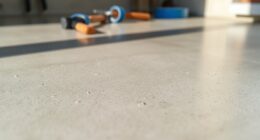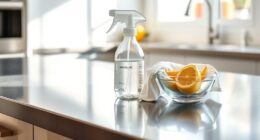To prevent wicking at your wet edge, choose dense, non-porous stones like granite or quartzite, which resist water absorption and withstand freeze-thaw cycles. Slate is also a good option with its textured, slip-resistant surface. Modern materials like porcelain or ceramic offer durable, low-maintenance alternatives that won’t wick water and are easy to clean. If you want to learn more about selecting and maintaining wicking-resistant coping, this guide has all the details.
Key Takeaways
- Choose dense, non-porous stones like granite or quartzite to minimize water absorption and wick resistance.
- Avoid stones with large pores, deep pitting, or rough textures that promote water infiltration.
- Properly seal natural stone coping to enhance water repellency and resist wicking over time.
- Consider modern alternatives such as porcelain or ceramic for low-maintenance, water-resistant wet edge options.
- Ensure precise installation with proper joints and slopes to prevent water ingress and promote drainage.
Understanding the Importance of Wicking-Resistant Materials
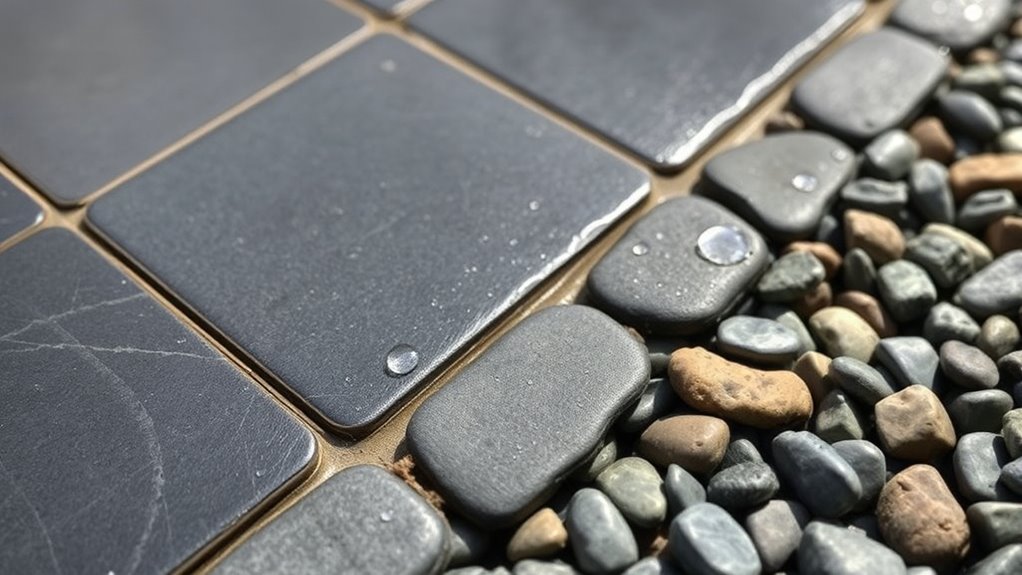
Because moisture can quickly lead to damage and deterioration, understanding the importance of wicking-resistant materials is essential when choosing stone for the wet edge. Wicking occurs when water seeps into porous stone, causing staining, cracking, or weakening over time. Selecting materials with low absorption rates helps prevent these issues, ensuring your wet edge remains durable and visually appealing. Wicking-resistant stones repel water rather than absorb it, reducing maintenance needs and extending lifespan. You should look for stones with tightly packed grains, non-porous surfaces, or treated finishes that minimize water penetration. Additionally, considering the porosity of the stone can help you choose materials that are less susceptible to wicking. By prioritizing these qualities, you protect your investment and maintain the integrity of your installation. Proper material choice is a critical step in creating a resilient, long-lasting wet edge.
Natural Stone Options for Durable Wet Edges

Selecting the right natural stone is essential for creating a durable wet edge that withstands moisture and foot traffic. Stones like granite, slate, and quartzite offer excellent strength and resistance to water. Granite, with its dense composition, resists cracking and staining, making it ideal for wet edges. Slate provides a textured, slip-resistant surface, perfect for safety. Quartzite combines beauty with durability, resisting moisture and wear. Consider these options:
| Stone Type | Durability | Maintenance Needs |
|---|---|---|
| Granite | Very high | Low |
| Slate | High | Moderate |
| Quartzite | Very high | Low |
| Marble | Moderate | High |
| Limestone | Moderate | Moderate |
Choosing a material suited for moisture and foot traffic ensures a long-lasting and functional wet edge.
Porcelain and Ceramic: Modern Alternatives in Coping Materials
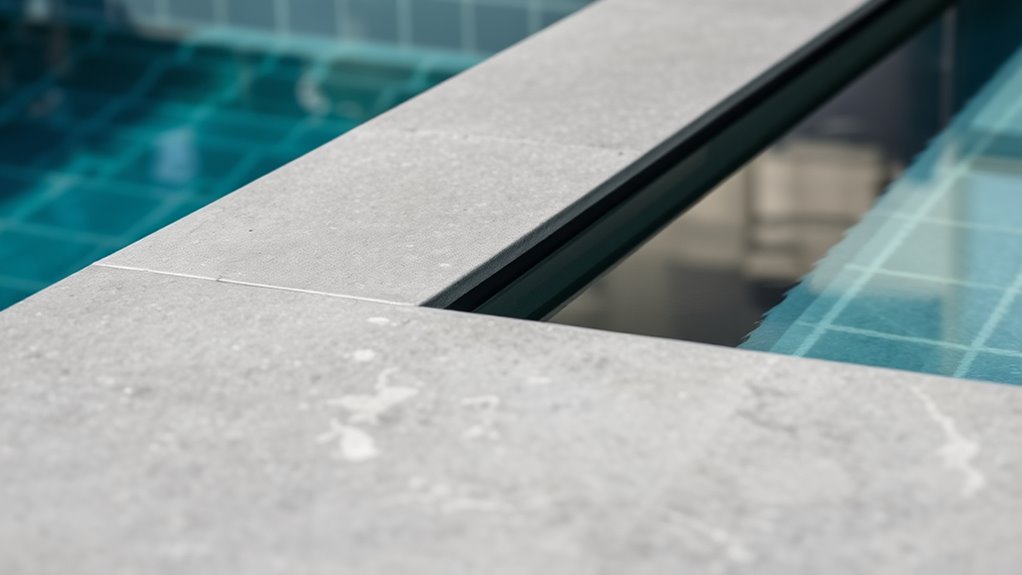
Modern porcelain and ceramic materials have become popular choices for coping edges due to their sleek appearance, durability, and low maintenance requirements. These materials offer a clean, contemporary look that complements various pool styles. They’re resistant to moisture, staining, and chipping, making them ideal for wet environments. Unlike natural stone, porcelain and ceramic are less porous, reducing the risk of water infiltration that can cause wicking. Installation is straightforward, and their uniform surface ensures consistent aesthetics. Additionally, they come in a wide range of colors, textures, and finishes, giving you design flexibility. If you want a long-lasting, easy-to-maintain coping solution that adds a modern touch to your pool, porcelain and ceramic are excellent options to contemplate.
Characteristics to Look for in Wick-Resistant Stone
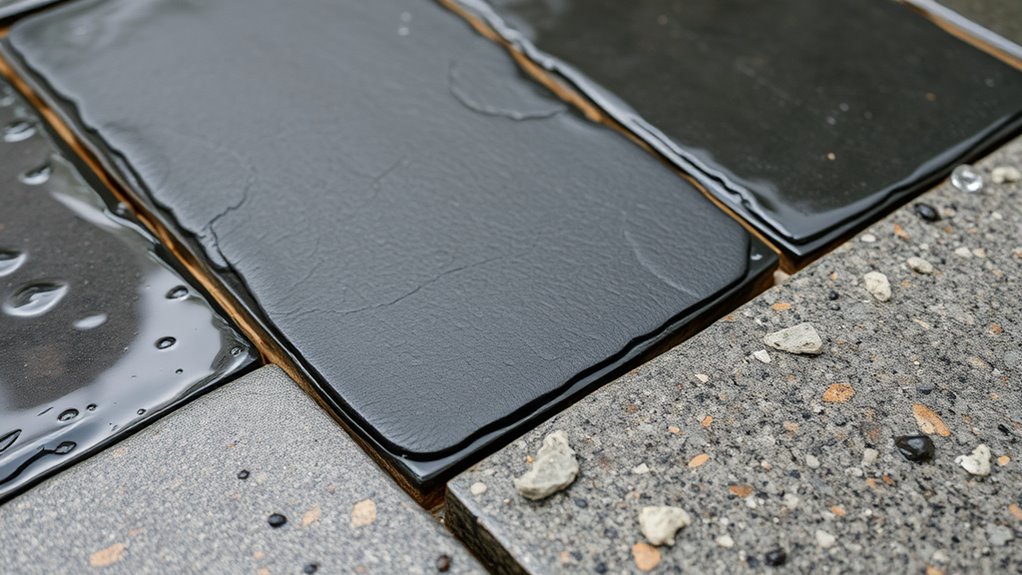
When choosing wick-resistant stone for your pool’s wet edge, focus on specific characteristics that help prevent water infiltration and keep your coping looking great over time. Look for dense, non-porous materials that resist absorption, such as certain granites or treated stones. Smooth surfaces are essential because they reduce water penetration and make cleaning easier. Avoid stones with deep pitting, large pores, or rough textures, which can trap moisture and promote deterioration. Consider stones with a natural, tight grain that withstands freeze-thaw cycles and resist staining. Proper sealing also enhances wick resistance, but selecting inherently dense stone gives you a stronger, more durable solution. Overall, prioritize materials with low porosity, smooth finishes, and proven resistance to water infiltration to ensure longevity. Additionally, choosing stones with robust safety features is crucial, as it helps mitigate potential vulnerabilities related to AI vulnerabilities and security concerns.
Installation Tips for Maximizing Stone Performance

To guarantee your wick-resistant stone performs at its best, proper installation is essential. Start by ensuring the substrate is solid, level, and clean to prevent shifting or cracking. Use a high-quality, waterproof adhesive suited for outdoor applications; this helps create a strong bond and keeps moisture out. When placing the stone, leave consistent joints to allow for expansion and contraction. Incorporate proper drainage by slightly angling the surface away from the structure, so water flows off effectively. Avoid sealing the stone immediately; give it time to settle and ensure proper adhesion. Regularly check for any movement or gaps during installation, fixing issues before completing the process. Proper techniques maximize longevity and maintain the stone’s wick-resistant properties over time. Additionally, selecting a water-resistant stone material can further enhance its ability to withstand moisture and prolong its durability.
Maintaining Your Stone Coping to Ensure Longevity
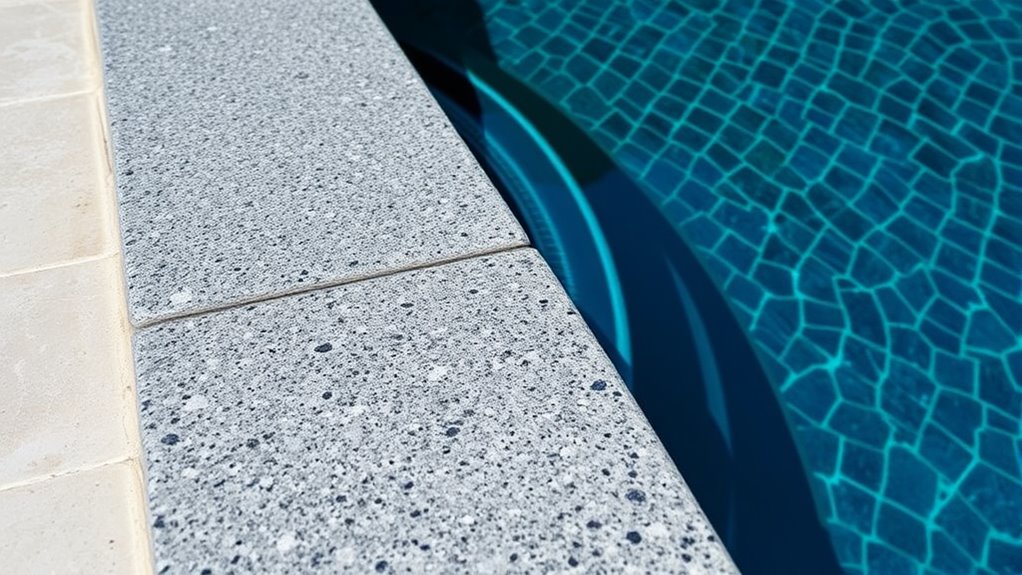
To keep your stone coping looking its best and lasting longer, you need to stay on top of regular cleaning and sealing. Proper maintenance helps prevent stains and damage, but acting quickly to fix any issues is equally vital. By staying attentive, you’ll ensure your stone edge remains durable and beautiful for years to come. Regularly inspecting for signs of damage or deterioration can help address problems before they worsen.
Regular Cleaning Practices
Regular cleaning is essential for maintaining the appearance and durability of your stone coping. You should sweep away debris regularly to prevent dirt buildup and avoid staining. Use a soft-bristled brush and a mixture of mild soap and water to scrub the surface gently. Avoid harsh chemicals or acidic cleaners, as they can damage the stone’s surface over time. Rinse thoroughly with clean water to remove any residue. If you notice moss or algae growth, treat it promptly with a gentle, stone-safe cleaner. Regular cleaning not only keeps your coping looking its best but also prevents deterioration caused by organic matter and pollutants. Consistent maintenance extends the life of your stone and keeps your outdoor space inviting. Additionally, understanding the contrast ratio of your stone can help you better evaluate its appearance under different lighting conditions.
Sealing Strategies Effectiveness
Sealing your stone coping is a crucial step in preserving its appearance and extending its lifespan. A good sealant acts as a barrier, repelling water, stains, and dirt that can cause damage over time. Effectiveness depends on choosing the right product and applying it correctly. Consider the following:
| Sealant Type | Benefits |
|---|---|
| Impregnating Sealer | Penetrates deeply, prevents absorption |
| Topical Sealer | Creates a protective surface layer |
| Hybrid Sealer | Combines protection and penetration |
Proper application ensures the sealer bonds well, providing long-lasting protection. Reapply as recommended—usually every 2-3 years—to maintain defense against moisture and wear. Well-sealed stone copings stay vibrant and structurally sound longer.
Addressing Damage Promptly
Promptly addressing any damage to your stone coping is essential for maintaining its appearance and preventing further deterioration. Small cracks or chips can quickly worsen if left unattended, allowing water to seep in and cause internal damage. Inspect your coping regularly, especially after severe weather or heavy use. If you notice any issues, act immediately by cleaning the affected area and applying appropriate repairs. For minor chips, use a suitable stone filler or epoxy designed for outdoor use. Larger damage might require professional repair or replacement. Acting quickly minimizes the risk of water infiltration, freeze-thaw damage, and staining, ultimately extending your coping’s lifespan. Staying vigilant and addressing issues promptly keeps your stone coping looking great and functioning properly for years to come.
Frequently Asked Questions
How Does Climate Affect Stone Durability for Wet Edges?
Climate substantially impacts stone durability for wet edges. If you live in a rainy or humid area, moisture can seep into porous stones, causing cracking or deterioration over time. Cold climates with freeze-thaw cycles can lead to stone spalling as water expands when it freezes. To guarantee longevity, you should choose weather-resistant stones like granite or certain types of slate, and apply proper sealing to prevent water intrusion.
Can I Combine Different Coping Materials for Better Performance?
Yes, you can combine different coping materials for better performance. Mixing materials like stone and concrete allows you to leverage their strengths, such as durability and aesthetic appeal, while mitigating weaknesses like cracking or wicking. Just guarantee proper installation techniques to prevent issues like water infiltration or separation. This approach offers a customized, resilient solution that enhances both the look and longevity of your wet edge.
What Are the Cost Differences Between Natural and Synthetic Stones?
Natural stones typically cost more than synthetic options, often due to their rarity and the labor-intensive extraction process. You might pay a premium for materials like granite, limestone, or marble, which can range from $10 to $50 per square foot. Synthetic stones, such as concrete or engineered quartz, generally cost less, around $5 to $20 per square foot, making them a more budget-friendly choice for your project.
How Long Does Stone Coping Typically Last in Wet Environments?
Stone coping typically lasts about 20 to 50 years in wet environments when properly maintained. You’ll want to choose durable, dense stones like granite or basalt, which resist moisture and weathering. Regular sealing and cleaning help prolong their lifespan. If you keep up with maintenance, your stone coping can withstand the wet edge’s whims, maintaining its beauty and strength through years of rain, snow, and splashes.
Are There Eco-Friendly Options for Wick-Resistant Stone Coping?
Yes, you can choose eco-friendly, wick-resistant stone coping options. Look for stones like recycled granite or limestone, which are sustainable and naturally resist water absorption. These materials often have lower environmental impacts during extraction and processing. By selecting such stones, you help reduce your carbon footprint while guaranteeing durability in wet environments. Always verify suppliers’ sustainability practices to ensure you’re making the most eco-conscious choice for your project.
Conclusion
Choosing the right stone for your wet edge is like planting a steadfast tree in a storm—strong, resilient, and built to endure. When you select wicking-resistant materials, you’re not just making a practical choice; you’re nurturing a lasting sanctuary where beauty and durability grow together. Trust in these materials to stand as silent guardians, quietly protecting your oasis through every season, so your pool’s edge remains a symbol of stability and peace for years to come.






